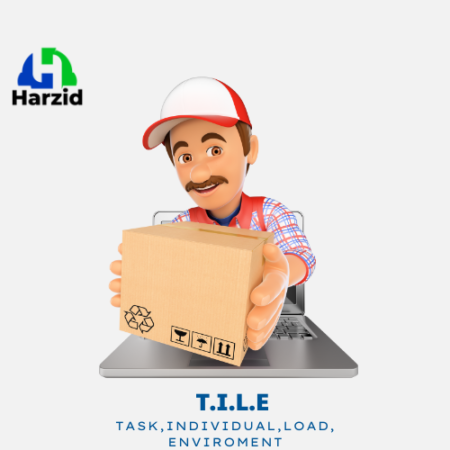
Manual handling is a common activity in many workplaces, from offices to construction sites. It involves lifting, carrying, pushing, pulling, or moving objects manually. While it may seem like a simple task, improper manual handling can lead to serious injuries, particularly to the back, neck, and shoulders. In fact, manual handling injuries are one of the leading causes of workplace accidents.
To promote safe manual handling, it’s important to follow best practices, and one useful method is the ‘TILE’ acronym. TILE helps you assess the risk involved in manual handling tasks by breaking down the essential factors to consider. Let’s explore what TILE stands for and how it can help you handle tasks safely and effectively.
T – Task: What Does the Job Involve?
The first element in TILE is the Task itself. Before lifting or moving an object, think about what the task requires and identify any potential risks. Ask yourself these key questions:
– Does the task involve repetitive movements or twisting?
– Will you need to carry the load over a long distance?
– Does the task require you to bend down or reach above shoulder height?
For example, if you need to move a heavy box from a low shelf to a high shelf, the task involves bending, lifting, and reaching, all of which increase the risk of strain. By analysing the task in advance, you can plan your movements, take breaks if needed, and adjust your posture to reduce the risk of injury.
Tip: Break down large or complex tasks into smaller, more manageable steps to reduce strain.

I – Individual: Are You Capable of Performing the Task?
The ‘Individual’ element refers to the person doing the task. Every individual has different capabilities, and it’s important to be realistic about what you can safely handle. Consider factors such as:
– Your physical strength and fitness level.
– Any pre-existing medical conditions, like back problems.
– Your training or experience with manual handling tasks.
Some tasks may be too heavy or awkward for one person to manage. In such cases, it’s crucial to ask for help or use mechanical aids like trolleys or lifting equipment to assist you.
Tip: Listen to your body. If you feel uncomfortable or sense strain while lifting, stop and reassess how you’re handling the load.
L – Load: What Are You Lifting?
The ‘Load’ refers to the object you are moving. Is it heavy, bulky, or awkwardly shaped? Some loads may be small but dense, while others may be large and difficult to grip. Assess the load carefully to determine the safest way to lift and carry it. Key considerations include:
– The weight and size of the load.
– How stable or unpredictable the load is (e.g., a container of liquid vs. a solid object).
– Whether the load has handles or grips that make it easier to hold.
If the load is too heavy, awkward, or lacks proper grips, you may need to use lifting aids or modify your handling technique to ensure safety.
Tip: Always test the load’s weight before fully lifting it by gently lifting one corner. This will help you gauge if it’s manageable.
E – Environment: Is Your Work Area Safe?
The Environment is the final aspect of TILE and focuses on the area where the manual handling task is being performed. The environment plays a huge role in your ability to safely move objects. Consider these factors:
– Is there enough space to manoeuvre the load?
– Are there any obstacles or uneven surfaces that could cause tripping?
– Is the floor slippery or wet?
– Is the lighting sufficient for you to see clearly?
Before you start a manual handling task, ensure the workspace is free of hazards and provides enough room for safe movement. In some cases, you may need to clear away obstacles, adjust lighting, or relocate the task to a safer area.
Tip: Ensure pathways are clear, and always be aware of your surroundings when moving loads, especially in busy environments.
Putting TILE into Action
Now that you understand the TILE acronym, here’s a quick step-by-step guide to applying it before any manual handling task:
- Assess the Task: Identify if there are repetitive motions, awkward postures, or long distances involved.
- Consider the Individual: Be honest about your abilities and ask for help if needed.
- Evaluate the Load: Check if the load is manageable, well-balanced, and stable.
- Inspect the Environment: Ensure your workspace is safe, spacious, and free from obstacles.
By using TILE, you can significantly reduce the risk of injury during manual handling tasks. It’s a simple yet effective way to keep yourself and your colleagues safe while maintaining efficiency in the workplace.
Techniques for Safe Manual Handling
– Lift with your legs, not your back. Bend at the knees and keep your back straight while lifting.
– Keep the load close to your body to reduce strain on your arms and back.
– Avoid twisting your torso while carrying a load. Turn your whole body instead.
– Take breaks during long or repetitive tasks to prevent fatigue.
Conclusion:
Manual handling is a part of everyday work in many industries, but it doesn’t have to result in injury. By applying the TILE acronym—Task, Individual, Load, Environment—you can assess the risks involved and take steps to protect yourself. Remember, safety is always the priority, so don’t hesitate to ask for help or use lifting aids when needed. Stay safe, work smart, and keep TILE in mind for all your manual handling tasks!



